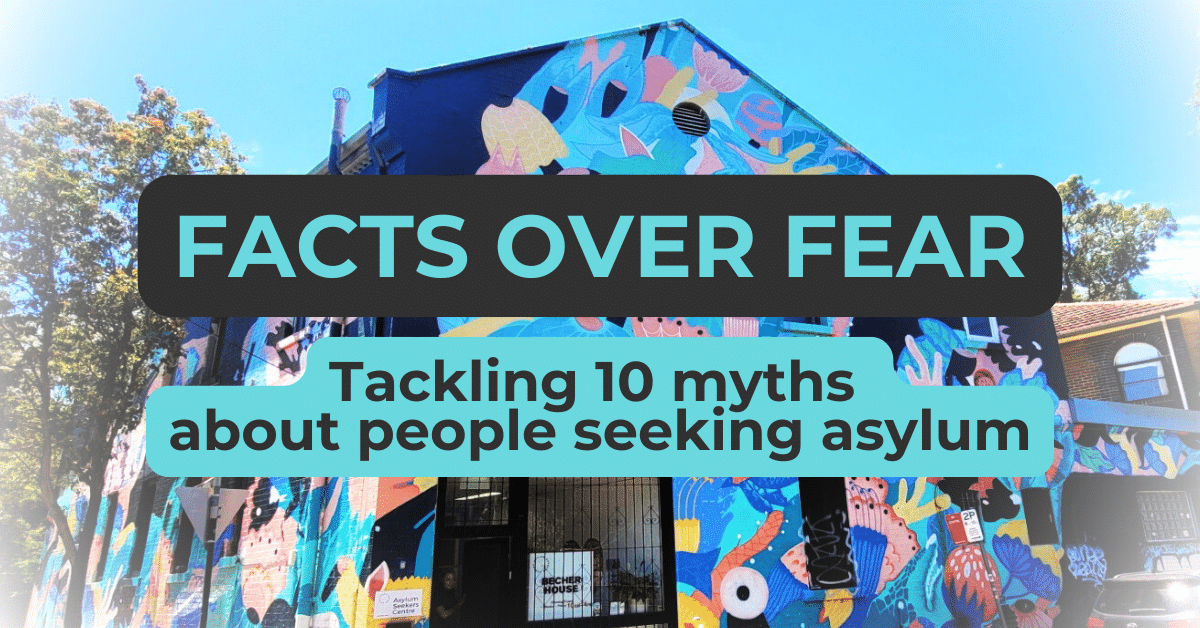SRSS: The gutted lifeline
In Australia today, people seeking asylum are locked out of the mainstream systems most of us rely on in times… Read More

The lives of people seeking safety have been politicised in Australia for decades, with politicians fearmongering in a grab for votes.
But the political race to the bottom over people seeking asylum and refugees is clouded with myths and misconceptions. It fails to reflect that we are talking about real people who are forced to flee danger, as well as the fact that it is a human right to seek asylum.
In a world where political discourse is plumbing new depths of hostility, it is crucial now more than ever to embrace facts over fear and division.
✅ Fact: Everyone has the right to seek asylum, regardless of how they arrive in Australia. Seeking asylum is a human right according to the Universal Declaration of Human Rights and the 1951 Refugee Convention, both of which Australia is a signatory.
✅ Fact: People seeking asylum have been denied refugee status and permanent protection visas even where they have legitimate reasons for fleeing their home country such as threat of war, persecution, and human rights violations. The refugee status determination process is broken and review mechanisms are equally flawed.
The “Fast Track” process also discriminated against people seeking asylum who arrived by sea. Thousands of people were denied permanent protection visas, forced into temporary stays of three or five years, leaving families torn apart and lives in limbo.
*Read the story of Quinton, a person seeking asylum failed by the ‘fast track’ system.
✅ Fact: People seeking safety do not have a mainstream safety net. They are prevented from mainstream social support such as Centrelink, housing assistance, and childcare subsidies. Some people have limited or no access to work rights or Medicare.
Instead, only around 2 per cent of people seeking asylum receive assistance through the flawed and dwindling Status Resolution Support Services (SRSS) program capped at around 89 per cent of the Newstart allowance. In the latest Federal Budget, the government slashed funding for this assistance by a further $20 million.
✅ Fact: There is no queue and only a tiny fraction of the world’s refugees have access to resettlement options. In many countries that people seeking asylum come from, there is no way to apply for refugee status.
Refugee Action Coalition estimates that if a global queue did actually exist, people joining the back of the queue might wait more than 180 years for resettlement.
✅ Fact: People seeking asylum do not have access to public housing, rental assistance or most transitional housing, and have limited access to homelessness services.
Many people seeking asylum are now facing unprecedented destitution and homelessness.
✅ Fact: People seeking asylum are structurally excluded from accessing childcare subsidies that Australian families depend on to afford early childhood education, and ensure parents can balance work and childcare.
On top of this, children of people seeking asylum have additional developmental needs due to the trauma they and their parents have experienced. However without subsidies, most families are unable to access this vital support.
✅ Fact: As a signatory of the 1951 Refugee Convention and Universal Declaration of Human Rights, Australia is bound to protect refugees in and has ample resources to do so. By reforming broken policies and expanding its refugee intake, Australia can play a key role in addressing the global displacement crisis.
The Australian government must also respect international law and end policies that breach our international obligations, including the cruel offshore detention regime.
✅ Fact: Despite ranking high in refugee resettlement, Australia’s intake isn’t as generous as it seems. Between 2013 and 2023, Australia received 13.1 per cent of resettled refugees globally, yet it only recognised 0.21 per cent of the 22.98 million refugees granted status worldwide.
Compared to its national wealth, Australia ranked 109th, accepting just 35 refugees for every $1 billion of GDP. This places it far behind nations like Austria (539 per $1 billion GDP), Germany (487) and Netherlands (216), which host greater numbers of refugees relative to their economic size.
*Read Refugee Council of Australia’s full analysis here.
✅ Fact: People seeking asylum are not picking and choosing where to go—they are following the difficult and dangerous path toward survival and safety.
Many people seeking asylum who arrive onshore in Australia are not secondary movers. Secondary movements primarily happen when people seeking asylum are forced to move because the first country they transited from is unable to provide safety and resources, or is not a signatory of the Refugee Convention. This would mean people seeking asylum would be at great risk if they stayed there.
✅ Fact: Australia has the resources to support those in need. This myth is ‘othering’ and sets up a false choice, implying that helping people seeking asylum cancels out the ability to help vulnerable Australians.
More humane asylum seeking processes and policies would in fact be more cost effective than mandatory detention or offshore processing which the Australian government spends hundreds of millions on annually, including $604 million in the latest Federal Budget.
These are some of the most prevalent of many misconceptions surrounding people seeking asylum, but there’s much more to learn. It’s important to dive deeper, challenge what we think we know, and explore the truths that often get overlooked in the public debate. People seeking asylum aren’t strangers—they’re our neighbours, coworkers, friends, and fellow human beings, facing unimaginable hardship in search of safety.
By rejecting divisive myths and embracing asylum seeker facts, we can create a society that doesn’t just offer refuge, but upholds human dignity and extends a genuine welcome.
In Australia today, people seeking asylum are locked out of the mainstream systems most of us rely on in times… Read More
Meet James, a steady presence at the Centre Support Desk In the Asylum Seekers Centre’s main halls, there’s a desk… Read More
"*" indicates required fields
